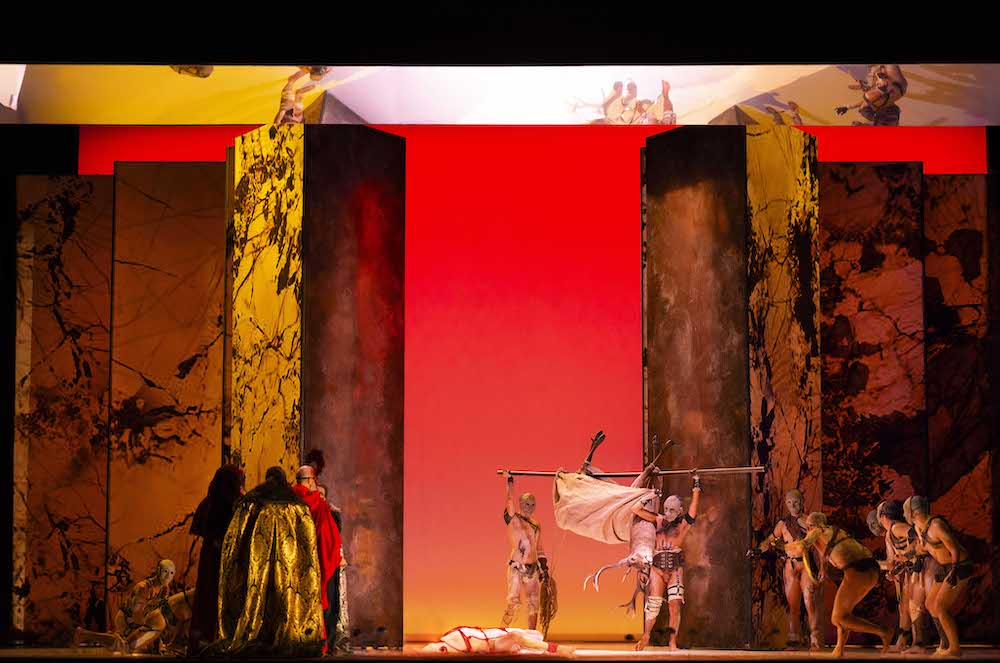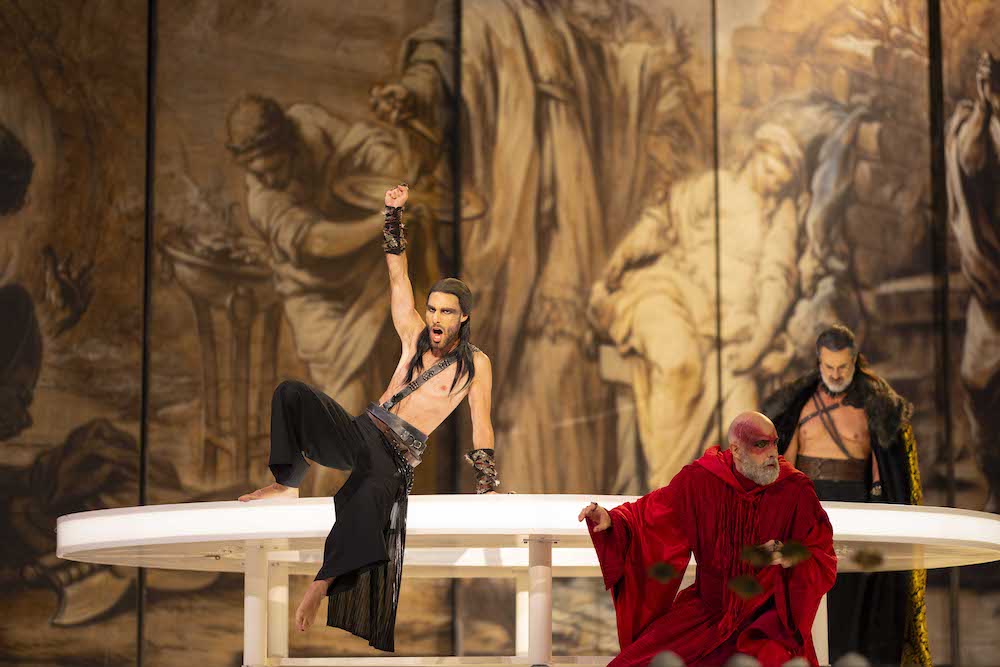Ifigenia in Aulide: Bayreuth Baroque 2024 opens with the modern premiere of Porpora’s 1735 opera
It was with an opera by Nicola Antonio Porpora – Carlo il Calvo – that Bayreuth Baroque was inaugurated, mid-pandemic, in 2020. The Neapolitan composer was again the choice of Max Emanuel Cencic, the festival’s founding artistic director, to launch its fifth edition. With Christophe Rousset’s Les Talens Lyriques as orchestra-in-residence he presented the first modern performance of Ifigenia in Aulide. It was composed for a London company, the Opera of the Nobility, founded in 1733 as a rival to Handel’s Royal Academy of Music, and its 1735 premiere was adorned by three of the era’s vocal superstars: the castrati Farinelli and Senesino and the soprano Francesca Cuzzoni. Nearly 300 years later, the sense of occasion was heightened by the venue, Bayreuth’s breathtaking Margravial Opera House, built in the 1740s and now a UNESCO World Heritage site. Its 500-seat wooden auditorium, with its trompe l’oeil decoration in dusty blue and matt gold, has survived intact. (The theatre also remained astonishingly cool and comfortable on a day when temperatures had surpassed 30 degrees Centigrade.) In addition to taking the role of Agamennone, originally assigned to Senesino, Cencic directed the production.
The libretto of the three-act opera is by Paolo Antonio Rolli, who also collaborated with Handel and Bononcini, and the basic trajectory of the plot is familiar to modern audiences from Gluck’s later Iphigénie en Aulide. The Greek armies, assembled in the port city of Aulis, are ready to set sail for Troy, but Agamemnon has offended the goddess Diana by killing a sacred stag in her forest. She has caused the winds to drop and the Greeks, eager for vengeance against the Trojans, are immobilised. The priest Kalchas (Calcante) proclaims that Diana can be assuaged through the sacrifice of Agamemnon’s daughter Iphigeneia (Ifigenia). She is summoned to Aulis with her mother, Clytemnestra (Clitennestra), on the pretext of marriage to the hero Achilles (Achille). When Iphigeneia and Achilles meet they fall instantly in love. Agamemnon is torn between his paternal instincts and his duty as leader of the increasingly restive Greek armies. Achilles, who is pitted against Kalchas, attempts to smuggle Iphigeneia out of Aulis, but finally, in order to resolve the conflict, she calmly submits herself for sacrifice. Her gesture placates Diana, who commands Iphigeneia to become her priestess in Tauris. The assembled Greeks praise the goddess.

While paying tribute to Classical Greece and an 18th century aesthetic, Cencic, working with designer Giorgina Germanou, took a decidedly 21st century approach. The threat of savagery lurked constantly: although we saw no blood and gore, there was no doubt that these legendary Hellenes could behave like barbarians. On his first appearance Agamennone – like his tribe of silent, thuggish henchmen, who were bearing the dead stag on a pole – was naked from the waist down. In the last of the three acts, as the sacrifice seemed inevitable, drums were beaten ominously on the stage. After the final notes of the jubilant final chorus, just as violence seemed to have been averted, the drums sounded out again as the lights faded, no doubt presaging the subsequent war and the murderous agonies of the House of Atreus. At times, Calcante, in his scarlet cassock-like robes, became frenzied in his
zealotry. His counterweight, the auburn-maned Achille, expressed more temperate – even enlightened – sentiments, but could still evince the macho swagger of a warrior.
Ifigenia was played by both a silent actress, Marina Diakoumakou, and a soprano, Jasmin Delfs. Diakoumakou wore a simple white shift, while Delfs, in shiny black finery, was masked and sported deer’s antlers. Presumably this denoted that she was in Diana’s power from the start – and it was Delfs who sang the goddess’s recitative and aria when she intervened in the final scene. Maybe intentionally, this doubling of the role was emotionally alienating: Diakoumakou became a beautiful cipher and Delfs’ pure-toned singing, though miraculously poised and accurate, retained a certain coolness, partly because she made comparatively little of the text
The scenery, at times suggesting a kind of oligarch chic, comprised a number of mobile components. Most prominent among these was a set of tall triangular prisms. Each of their rectangular sides was different: the first carrying marbled markings, the second sepia paintings of figures, and the third a reflective sheen that echoed the mirrored frame round the proscenium. In addition there was a luminous, milky-white sacrificial table and illuminated glass boxes containing leafless golden trees. The reflective surfaces were used to striking effect in the opera’s most powerful scene: in Act 2, as Agamennone pictured the sacrifice, multiple blurred images of Calcante grasping his victim could be glimpsed around the stage. Although, as was announced before the opera, Cencic was suffering from a respiratory infection, this recitative and aria proved quite a tour de force. Striking a noble, but tortured figure, and singing and declaiming with searing intensity, the countertenor summoned considerable power in the higher reaches of his voice and there was a velvety allure to his lower registers.
As Achille, the Farinelli role, Maayan Licht matched Cencic’s virtuosity, though there is less amplitude to his tone. When not dispatching cascades of coloratura he relished opportunities for the utmost sensitivity and delicacy, above all in his extended aria near the beginning of Act 3, another highlight of the score. Punctuating the inevitable opera seria sequence of solo showpieces, the previous act had ended with a thrillingly combative duet between Achille and Calcante, sung by Riccardo Novaro. The dogmatic priest becomes the villain of the piece, and if the role perhaps presupposes a more tenebrous, less mellifluous voice than Novaro’s, his vibrant projection of both music and his text, and the way his expansive gestures matched his vocal fulminations, ensured he was a dominant force.

The sole trio in the piece comes in Act 3, as Agamennone, Ifigenia and Clitennestra contemplate the imminent sacrifice. Though Mary-Ellen Nesi’s relatively soft-grained timbre was not quite as imposing as her towering queenly coiffure, her interventions throughout the opera were authoritative and heartfelt, whether compassionate, furious or desperate. The cast was completed by Nicolò Balducci as Ulisse; while not enmeshed in the action, the character is honoured with the first arias in both Act 1 and Act 2. The coloration of Balducci’s voice, like Licht’s, is more soprano than alto, and he set the scene with brilliance and dynamism, while physically implying the cunning that typifies the King of Ithaca.
Porpora was renowned as a singing teacher and Bayreuth Baroque’s programme note suggested that, in contrast to the Handel (who was just a year older), his prime concern remained vocal display rather than psychological insight. While offering a wealth of spectacular singing, this Ifigenia in Aulide was by no means short of dramatic tension. Moreover, if Porpora’s music is often very much in the same vein as Handel’s, here – in an acoustic that seemed especially sympathetic to the cultivated sonorities of Les Talens Lyriques – it offered an arresting sensuousness, above all at moments where the instrumental writing interacted with the voices rather than simply accompanying them. Christophe Rousset’s approach undoubtedly played a part in this: while some historically informed conductors seem eager to grab attention with extreme contrasts of timbres and tempo and isolated special effects, he favoured a coherent and satisfying musico-dramatic flow. The term might be anachronistic in the context of the Baroque, but it is geographically apposite: Rousset knows exactly where he belongs in the Gesamtkunstwerk.
Ifigenia in Aulide will be video-broadcast live on BR Klassik on 15th September at 19:00 CET.
Yehuda Shapiro
Ifigenia in Aulid Music composed by Nicola Antonio Porpora, Libretto by Paolo Antonio Rolli
Cast and production staff:
Jasmin Delfs – Ifigenia; Max Emanuel Cencic – Agamennone; Maayan Licht – Achille; Mary-Ellen Nesi – Clitennestra; Riccardo Novaro – Calcante; Nicolò Balducci – UlisseDirector – Max Emanuel Cencic; Assistant Director – Constantina Psoma; Set & Costumes – Giorgina Germanou; Lighting – Romain de Lagarde; Conductor – Christophe Rousset; Orchestra – Les Talens Lyriques.
Margravial Opera House, Bayreuth, 5 September 2024. Photos: Clemens Manser/Falk von Traubenber